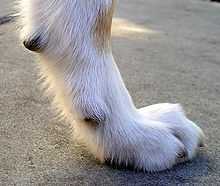Paw

Common characteristics
The paw is characterised by thin, pigmented, keratinised, hairless epidermis covering subcutaneous, collagenous, and adipose tissue, which make up the pads. These pads act as a cushion for the load-bearing limbs of the animal. The paw consists of the large, heart-shaped metacarpal or palmar pad (forelimb) or metatarsal or plantar pad (rear limb), and generally four load-bearing digital pads, although there can be five or six toes in the case of bears and the Giant Panda. A carpal pad is also found on the forelimb which is used for additional traction when stopping or descending a slope in digitigrade species. Additional dewclaws can also be present.
The paw also includes a horny, beak shaped claw on each digit. Though usually hairless, certain animals do have fur on the soles of their paws. An example is the Red Panda, whose furry soles help insulate them in their snowy habitat.
Animals with paws
- Felines, such as cats and tigers; some of these animals may have toe tufts
- Members of the Canidae family, such as dogs and foxes
- Rabbits have paws with very sharp nails and have no pads underneath them.
- Bears and Raccoons
- Weasels and other mustelids
- Rodents
-

A dog's paw resting on a hard concrete surface
-

A tiger's paw, showing pads
-

A cat's paw, showing pads
-

Structures of the leg and paw of a dog
-
Skeleton of a dog paw
See also
| Wikimedia Commons has media related to Paws. |
